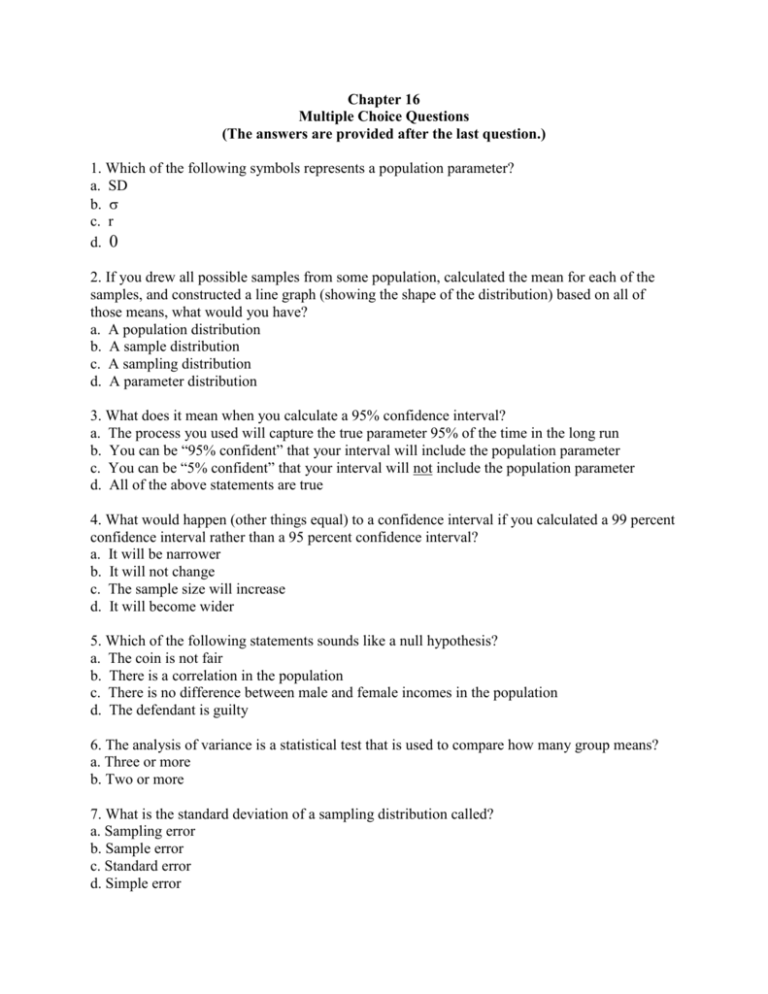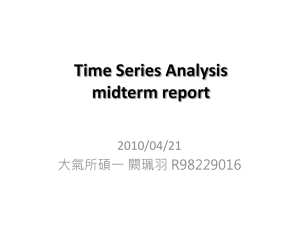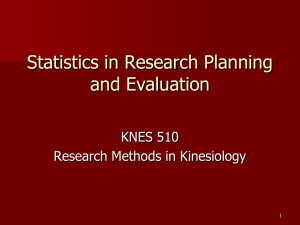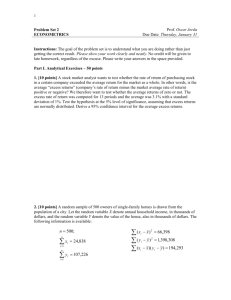Statistics Multiple Choice Questions - Chapter 16
advertisement

Chapter 16 Multiple Choice Questions (The answers are provided after the last question.) 1. Which of the following symbols represents a population parameter? a. SD b. c. r d. 2. If you drew all possible samples from some population, calculated the mean for each of the samples, and constructed a line graph (showing the shape of the distribution) based on all of those means, what would you have? a. A population distribution b. A sample distribution c. A sampling distribution d. A parameter distribution 3. What does it mean when you calculate a 95% confidence interval? a. The process you used will capture the true parameter 95% of the time in the long run b. You can be “95% confident” that your interval will include the population parameter c. You can be “5% confident” that your interval will not include the population parameter d. All of the above statements are true 4. What would happen (other things equal) to a confidence interval if you calculated a 99 percent confidence interval rather than a 95 percent confidence interval? a. It will be narrower b. It will not change c. The sample size will increase d. It will become wider 5. Which of the following statements sounds like a null hypothesis? a. The coin is not fair b. There is a correlation in the population c. There is no difference between male and female incomes in the population d. The defendant is guilty 6. The analysis of variance is a statistical test that is used to compare how many group means? a. Three or more b. Two or more 7. What is the standard deviation of a sampling distribution called? a. Sampling error b. Sample error c. Standard error d. Simple error 8. Hypothesis testing and estimation are the two key branches of the field of inferential statistics? a. True b. False 9. A ______ is a subset of a _________. a. Sample, population b. Population, sample c. Statistic, parameter d. Parameter, statistic 10. A _______ is a numerical characteristic of a sample and a ______ is a numerical characteristic of a population. a. Sample, population b. Population, sample c. Statistic, parameter d. Parameter, statistic 11. A sampling distribution might be based on which of the following? a. Sample means b. Sample correlations c. Sample proportions d. All of the above 12. As a general rule, researchers tend to use ____ percent confidence intervals. a. 99% b. 95% c. 50% d. none of the above 13. Which of the following is the researcher usually interested in supporting when he or she is engaging in hypothesis testing? a. The alternative hypothesis b. The null hypothesis c. Both the alternative and null hypothesis d. Neither the alternative or null hypothesis 14. When p<.05 is reported in a journal article that you read for an observed relationship, it means that the author has rejected the null hypothesis (assuming that the author is using a significance or alpha level of .05). a. True b. False 15. When p>05 is reported in a journal article that you read for an observed relationship, it means that the author has rejected the null hypothesis (assuming that the author is using a significance or alpha level of .05). a. True b. False 16. _________ are the values that mark the boundaries of the confidence interval. a. Confidence intervals b. Confidence limits c. Levels of confidence d. Margin of error 17. _____ results if you fail to reject the null hypothesis when the null hypothesis is actually false. a. Type I error b. Type II error c. Type III error d. Type IV error 18. A good way to get a small standard error is to use a ________. a. Repeated sampling b. Small sample c. Large sample d. Large population 19. The car will probably cost about 16,000 dollars; this number sounds more like a(n): a. Point estimate b. Interval estimate 20. Identify which of the following steps would not be included in hypothesis testing. a. State the null and alternative hypotheses b. Set the significance level before the research study c. Eliminate all outliers d. Obtain the probability value using a computer program such as SPSS e. Compare the probability value to the significance level and make the statistical decision 21. A ________ is a range of numbers inferred from the sample that has a certain probability of including the population parameter over the long run. a. Hypothesis b. Lower limit c. Confidence interval d. Probability limit 22. ________ is the standard deviation of a sampling distribution. a. Standard error b. Sample standard deviation c. Replication error d. Meta error 23. An effect size indicator is a statistical measure of the strength of a relationship. a. True b. False 24. Which of the following can be viewed as an effect size indicator? a. r-squared b. r c. Eta-squared d. Omega-squared e. All of the above 25. When the researcher rejects a true null hypothesis, a ____ error occurs. a. Type I b. Type A c. Type II d. Type B 26. A post hoc test is ___. a. A test to compare two or more means in one overall test b. A test to determine regression to the mean c. A follow-up test to the analysis of variance when there are three or more groups d. A follow-up test to the independent t-test 27. The use of the laws of probability to make inferences and draw statistical conclusions about populations based on sample data is referred to as ___________. a. Descriptive statistics b. Inferential statistics c. Sample statistics d. Population statistics 28. A statistical test used to compare 2 or more group means is known as _____. a. One-way analysis of variance b. Post hoc test c. t-test for correlation coefficients d. Simple regression 29. A statistical test used to determine whether a correlation coefficient is statistically significant is called the ___________. a. One-way analysis of variance b. t-test for independent samples c. Chi-square test for contingency tables d. t-test for correlation coefficients 30. The cutoff the researcher uses to decide whether to reject the null hypothesis is called the: a. Significance level b. Alpha level c. Probability value d. Both a and b are correct 31. Which ____ percent confidence interval will be the widest (i.e., the least precise) for a particular data set that includes exactly 500 cases? a. 99% b. 95% c. 90% d. None of the above 32. As sample size goes up, what tends to happen to 95% confidence intervals? a. They become more precise b. They become more narrow c. They become wider d. Both a and b 33. __________ is the failure to reject a false null hypothesis. a. Type I error b. Type II error c. Type A error d. Type B error 34. Which of the following statements is/are true according to the logic of hypothesis testing? a. When the null hypothesis is true, it should be rejected b. When the null hypothesis is true, it should not be rejected c. When the null hypothesis is false, it should be rejected d. When the null hypothesis is false, it should not be rejected e. Both b and c are true 35. What is the key question in the field of statistical estimation? a. Based on my random sample, what is my estimate of the population parameter? b. Based on my random sample, what is my estimate of normal distribution? c. Is the value of my sample statistic unlikely enough for me to reject the null hypothesis? d. There is no key question in statistical estimation 36. Assuming innocence until “proven” guilty, a Type I error occurs when an innocent person is found guilty. a. True b. False 37. This is the difference between a sample statistic and the corresponding population parameter. a. Standard error b. Sampling error c. Difference error d. None of the above 38. The “equals” sign (=) is included in which hypothesis when conducting hypothesis testing? a. Null b. Alternative c. It can appear in both the null and the alternative hypothesis 39. A Type I error is also known as a ______. a. False positive b. False negative c. Double negative d. Positive negative 40. A Type II error is also known as a ______. a. False positive b. False negative c. Double negative d. Positive negative 41. If a finding is statistically significant one must also interpret the data, calculate an effect size indicator, and make an assessment of practical significance. a. True b. False 42. The p-value used in statistical significance testing should be used to assess how strong a relationship is. For example, if relationship A has a p=.04 and relationship B has a p=.03 then you can conclude that relationship B is stronger than relationship A. a. True b. False Answers: 1. b 2. c 3. d 4. d 5. c 6. b 7. c 8. a 9. a 10. c 11. d 12. b 13. a 14. a 15. b 16. b 17. b 18. c 19. a 20. c 21. c 22. a 23. a 24. e 25. a 26. c 27. b 28. a 29. d 30. d 31. a 32. d 33. b 34. e 35. a 36. a 37. b 38. a 39. a 40. b 41. a 42. b









